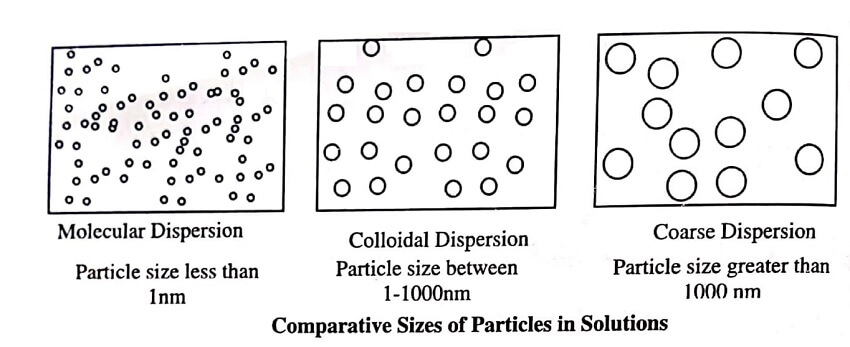The dispersion system is categorised in the following three groups based on the size of dispersed particles:
Molecular Dispersion: This system behaves as true solutions where the solute phase is present in the solvent phase. The solute (dispersed phase) is homogeneously distributed as separate molecules of size below 1nm (10-7 cm) throughout the solvent (dispersion medium). For example, air is a molecular mixture of oxygen, nitrogen, etc., electrolytes being the aqueous solutions of salts, and metal alloys solid solutions.
Colloidal Dispersion: Colloids are micro-sized heterogeneous dispersed systems, with dispersed phase particles ranging within 1-1000nm (10-7 – 10-5 cm) size. The separation of colloid phases cannot be achieved under gravity, centrifugal, or other forces.
Separation of colloidal dispersed phase from the dispersion medium is brought about by micro-filtration. For example, milk is the emulsion of fat and other substances in water, fog is an aerosol of water micro-droplets in air, and opal is colloidal silica.
Coarse Dispersion (Suspensions and Emulsions): This is a heterogeneous dispersed system having dispersed phase particles greater than 1000 nm. Coarse dispersions show comparatively fast dispersed phase sedimentation due to gravity or other forces. Dispersed phase separation from continuous phase is easy through filtration. For example, sand grains, pharmaceutical emulsions and suspensions, and RBCs.

This table enlists the differences between the different types of dispersed system:
Table: Differences between Molecular Dispersion, Colloidal Dispersion, and Coarse Dispersion
| Properties | Molecular Dispersion | Colloidal Dispersion | Coarse Dispersion |
| Particle size | Less than 1 nm | Between 1-1000nm | Greater than 1000nm |
| Visibility of particles | Invisible to naked eyes, but visible under a powerful microscope | Invisible to naked eyes, but visible under a powerful microscope | Easily visible |
| Sedimentation of particles | Do not settle down | Settle down under high centrifugation | Settle down due to gravity |
| Filtration through filter paper | No residue is formed | No residue is formed | Residue is formed |
| Read More Topics |
| Western Blotting |
| Large scale production fermenter design |
| Southern Blotting |





